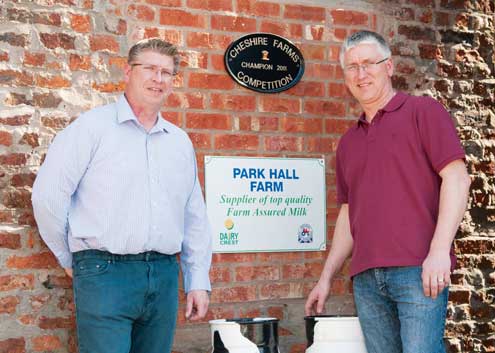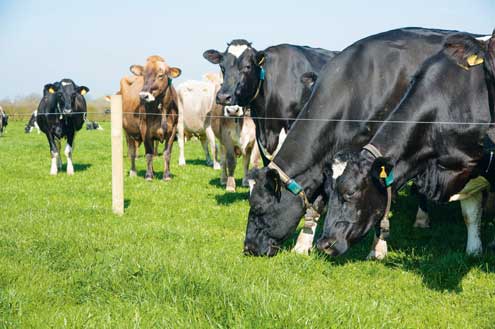Block calving helps simplify dairy system

They say one man’s loss is another man’s gain and nowhere is this more evident than at John and Phil Riley’s farm at Middlewich, Cheshire.
| Park Hall Farm facts |
|---|
|
Their move away from year-round calving to a late-summer block has been driven by buying-in stock that have slipped out of another farm’s spring calving block and calving them into their system.
Doing so allows stock to be bought at a reasonable price – and with the price of dairy cows so high, the difference between the farm’s cull and replacement costs is kept at an attractive level.
The move to block calving has been part of a complete system overhaul aimed at making more of the farm’s resources, simplifying and getting the most from the Dairy Crest liquid seasonality milk contract they signed in 2010.
This is the first season the herd has calved in a block from 1 June to 1 October, with the aim to calve all stock outside before they are housed in mid-October to keep the system simple. However, with this year’s wet summer, most of the July-calvers had to be calved inside.
“The poor weather this year meant cows were in and out during June and July and permanently housed during July and August,” John says.
“We also had to buy in 600t of grass silage and feed extra concentrate as silage is not as good quality as good summer grazing.”
Type of cow
In the past, when the farm was on a cheese contract, Jersey and Brown Swiss had been brought into the predominantly black-and-white herd to increase milk constituents. But in line with the new milk contract and emphasis on grazing, the Rileys are now buying mainly Jersey crosses and New Zealand Friesians.
John explains: “During the past eight to 10 years, as we’ve stopped rearing our own replacements, we moved to serving everything to British Blue. This gave us high-value calves in the sale ring compared to the less attractive Jersey crosses.
“However, now and again we were getting Holsteins that were struggling with big calves.”
One year, the farm bought their first group of 30 New Zealand Friesians that had slipped out of a spring block and were in-calf to Herefords. The experience with these easy-calving animals permanently changed the breeding strategy at Park Hall Farm.
“They were all easy-calving, produced a smaller calf and got back in calf easily,” John explains.
“From then on we decided to serve all the Holsteins to Aberdeen Angus. The slightly lower calf value was outweighed by reduced stress to the cow. With a reduced labour force and a condensed calving period, we need a cow that’s going to get on her feet and graze straight away.”

Replacements
All replacements are sourced from spring-calving herds as dry or stale and are bought in batches of mixed lactations, with 70 bought at the start of the year, that calved in July.
In October last year, they also bought 32 empty cows from a spring-calving herd. Paying just more than barren price, these cows were partly bought to make the most of some late season autumn grass, as well as replace stock that had slipped out of their block. They were AI’d with the rest of the herd, with 28 out of 32 pregnant.
| Moving to a later summer block – key points |
|---|
|
“Last year we finished calving on 5 November and sold any of our December-January calvers to buy these 36 replacements that would fit with our block,” says John.
To keep management as simple as possible, the brothers have not bought in-calf or fresh heifers for years.
John explains: “We want an animal that can look after itself and knows the job. We’re not interested in pedigree, we want regular time off and to finish at a good time, so we don’t want cows that need a lot of attention.
“That’s why, during the past five to six years, we’ve only bought in-calf cows. We can then get them on to our system on the right diet and calve on our farm.
“We have a replacement rate of about 29%, and although this may seem high, it’s because the herd is flying and made up of older cows. Our average lactation age is 4.4 – most people have lots of heifers that would pull this down.”
The Rileys hope this replacement rate will drop as the bigger Holsteins that struggle with mastitis and fertility eventually all leave the herd.
“Some of our stock are getting in-calf within 40 days of calving. Essentially it doesn’t matter what they look like, as long as they’re right on their feet and their teats are in the right direction.”
Heat detection
Moving to a block calving system has also given the brothers more focus on heat detection, which has been helped by the introduction of an automated oestrus detection system three years ago.
We had been using RMS, but felt this was an extra cost when we could do our own AI, says Phil.
“We thought we’d try automated heat detection, but had heard the biggest downside was swapping collars when cows were pregnant.”
Because the pair needed to borrow money anyway to install the system, they decided to buy enough for the then herd of 230 cows in one year. This could be paid back over four years. More collars have now been bought, using RDPE funding.
John explains: “There’s been a real benefit to keeping the collars on for the whole season, as they work on picking up heats as well as any illness, because activity decreases when cows are unwell.”
Auto-segregation gates draft out any bulling cows and stock is AI’d during September to October. A bull is then introduced in November or December when cows are housed.
“We’ll stop serving on 31 December, so we’re serving for four months and calving for four months,” says John.
“Some people might ask why we are not spring calving, but the main reasons are we can’t turn out cows in February and it’s also difficult to buy spring calving cows. Because our farm doesn’t dry up, we’ve also got the grass cover from August to October. It’s just down to management to keep the grass quality up.”
